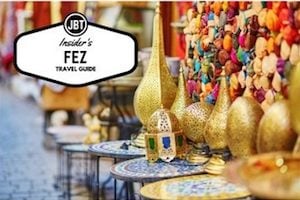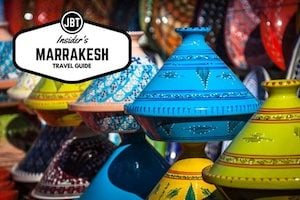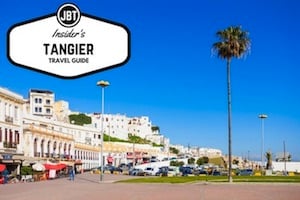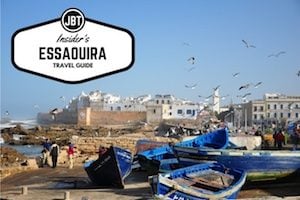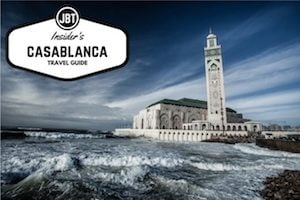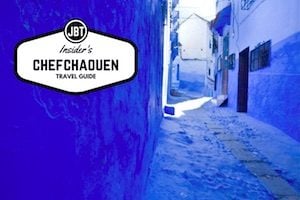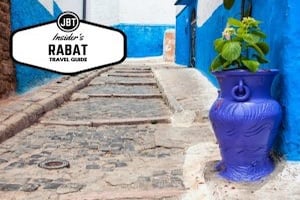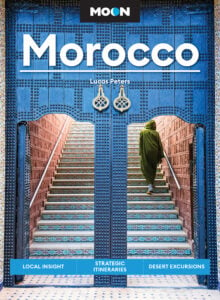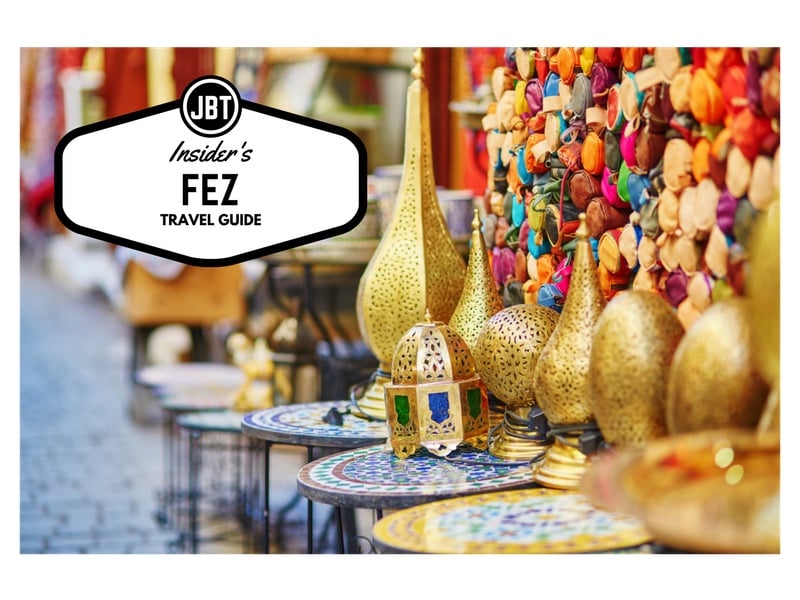 When you stroll beneath the famous blue gate of Bab Boujeloud, you are seemingly transported 1,000 years back in time. The bustling cafés and outdoor markets quickly give way to quiet narrow streets where children are hard at play and donkeys are hard at work carrying supplies up and down the twisting, mud brick corridors of the medieval city. This is the oldest part of Fez, Fez el-Bali, and it is the world’s largest car-free urban space as well as a UNESCO World Heritage Site. This is where most travelers spend their time in Fez.
When you stroll beneath the famous blue gate of Bab Boujeloud, you are seemingly transported 1,000 years back in time. The bustling cafés and outdoor markets quickly give way to quiet narrow streets where children are hard at play and donkeys are hard at work carrying supplies up and down the twisting, mud brick corridors of the medieval city. This is the oldest part of Fez, Fez el-Bali, and it is the world’s largest car-free urban space as well as a UNESCO World Heritage Site. This is where most travelers spend their time in Fez.
As you walk through Fez el-Bali, you are literally walking through 1,300 years of Moroccan heritage that has only recently been touched by the advent of globalization and the recent influx of tourists. Even with this uptick in tourism, the magic of Fez endures. The city has endured through so much history. Ancient mosques and medersas (often: madrassas, these are Islamic schools) are dotted throughout this labyrinthine city. Though non-muslims are not allowed into any of the mosques, there are two medersas — Medersa Bou Inania and Medersa el-Attarine — both of which give a sense of the splendor of the Islamic architecture. Note the balance of complex stucco and tile work used to decorate these architectural gems!
Fez Travel Guide: Video of Fez
Fez Travel Guide: Map of Fez Medina
Here is a map of the Fez medina. We include a similar map of Fez in each itinerary packet that travelers receive before their tour takes place with us at Journey Beyond Travel.

Besides the labyrinthine Fez el-Bali, there are two other parts to the city: Fez el-Jdid (the “new part of the city”, which is still a few hundred years old) and Ville Nouvelle (French for new city, constructed under the French Protectorate era in the first half of the 20th century). Though most of the activities and sites of interest to travelers is in the old city, many travelers do find themselves venturing into Fez el-Jdid to visit the Jewish Quarter, Dar Batha Museum and take a stroll in the Jnane Sbil gardens while most avoid the Ville Nouvelle altogether, unless they are traveling to the airport, train station or getting a bite to eat somewhere a bit more modern than the offerings in Fez el-Bali.
Fez is a medieval city, a heritage site, and for centuries, life has largely gone on unchanged. You’ll find that with globalization, Fez has become a melting pot of languages. Most store owners, waiters and other workers know or understand Arabic, French, English and many other languages. More and more, Moroccans are happy to practice English and will be happy to tell you that Morocco was the first country to recognize the United States of America as an independent country.
There is a continuous play between the bustle of small, winding medina passages and the quiet, reflective interior spaces that give Fez its charm. Today, the past mixes with the present in some unexpected ways for you to discover. All of this makes Fez a must-see destination for anyone in Morocco.
Notes from the History of Fez
Fez was founded in 789 A.D. by Moulay Idriss II, the son of the founder of modern Morocco, though the origin of the city’s name is unknown. Some scholars believe it comes from the old Berber name of the Middle Atlas mountains, Fazaz; while other stories trace the name back to a tale of a golden axe that divided the river of Fez into two halves (in Arabic, a fez is an axe).
It wasn’t until 817-18 A.D., when around 800 refugee families from Cordoba in Spain settled in Fez, followed a few years later by over 2,000 families from Tunisia, that Fez really began to grow. These settlements fought each other for over 300 years. It wasn’t until the arrival of the Almoravid empire in 1070 A.D. that the city had some measure of peace.
Under Almoravid rule, the city of Fez took form and the walls of Fez, walls which still form the outline of today’s Fez El-Bali, were erected. By 1170 A.D., Fez was the largest city in the world with over 200,000 people living in it. It was an important trading hub, serving Africa and Europe, the gold route from Timbuktu and the famous tanneries with their fine reputation for making leather shields.
When the Merenids took control of Morocco in 1250 A.D., they made Fez their capital. This is when Fez el-Jdid, the “new” city, was built with wider streets, gardens, and many administrative centers. This is also when Fez really became a cultural and intellectual hub and the “Fassi” style, a mix of Andalusian and Almohad traditions, was given birth. The Medersa Bou Inania and Medersa el-Attarine are excellent examples of the ornate architecture from this period.
Today, Fez is known as the “Athens of Africa” and the “Mecca of the West” for its history and role as the spiritual and learning capital of Morocco.
Fez Travel Guide: What to Do?
Get Lost! – The old city of Fez is a medieval labyrinth of small, winding streets. Many kids will tell you if you are reaching a dead end. An easy way to find your way out of the maze is to understand that Fez is shaped like a bowl. You will be walking downhill to enter the maze, which means you will have to walk uphill to get out… though you may find yourself somewhere unexpected. It’s a good idea to have change for a taxi to easily get from one “gate” of the city (like Bab Boujeloud) to another. If you can plan for a day to “get lost” in Fez, you will have a day to remember for a lifetime.
Stroll the Talaa Kebeera – Talaa Kebeera is the largest “street” in Fez. It begins shortly after Bab Boujeloud and continues on through much of the medina. Many different shops, souks and sights are located just off this main artery. Though often crowded by locals and tourists alike, it is a nice taste of old Fez.
Take a Guided Tour – Though less adventurous than getting lost, a guided tour through Fez is a great way to learn some of the history and orient yourself to this confusing medina. This is one of many included activities that one can enjoy on a private Morocco tour with our team. In Fez, you’ll chat with your local city guide about your interests before heading out for a full day of exploration.
Go to a Hammam (A Traditional Moroccan Bath) – After a couple of days in Fez, there is nothing like scrubbing yourself clean. There are several local hammams (or “public baths”) if you are interested in a local experience. You can ask the staff at your lodgings for the closest local hammam and they will happily show it to you and tell you the hours, which vary by location. You will need to bring your own soap, towel, scrub brush and other amenities. Most riads offer a more upscale experience with private and couples spa and massage.
Sacred Music Festival – Held every June, the Sacred Music Festival is one of the largest music festivals in Morocco featuring music from around the world. In 2025, the festival was held from May 16 – 24. Visit the Fez Sacred Music Festival website for up-to-date details.
Take a Cooking Class – Moroccan cuisine is often discussed with French and Italian cuisine as being one of the best in the world — and for good reason! Nothing brings together people like delicious food. Undoubtedly, you have tried some couscous, tajine or maybe a bowl of harrira. If you want to have a fun afternoon making your own lunch, meet some great people, and have a recipe to take home, why not head for an afternoon of cooking school? Café Clock has a great cooking class that includes a short guided tour of the food medina where you will learn all sorts of things about the food souks in Morocco. (600 dhs per person, be sure to book ahead by email: fez@cafeclock.com)
Fez Travel Guide: What to See in Fez el Bali
Bab Boujeloud – Bab Boujeloud (Bab Bou Jeloud), commonly known as the “Blue Gate,” serves as the principal entrance to the old Medina in Fez and is a good meeting point for groups. Through this gate, you can access the Talaa Kbeera (big hill) to your left and Talaa Sghira (little hill) to your right, past a series of restaurants all serving fairly similar Moroccan-style food. Both the Talaa Kbeera and Talaa Sghira are roads that lead down through the main thorough fares into the old medina and merge with each other further into the medina, near the Henna Souk. Bab Boujeloud and its immediate surroundings were all constructed around the turn of the 20th century. Notably, the French-built gate is blue on the exterior and green on the interior and bolted from the inside. Both façades are decorated with elaborate zellij work and are well worth a photo-op.
Medersa Bou Inania – You will see the green-tiled minaret of the Medersa Bou Inania jutting into the sky as you enter through the great blue gate of Bab Boujeloud into the old medina. The medersa is one of the greatest examples of the Merenid architecture in the 14th century. It might be best to visit the medersa with a tour guide to avoid any hassles, as sometimes non-Muslims are forbidden entrance because of the prayer times (Opened all days except Friday, hours vary).
Tanneries – “The smell is free… but if you want to buy, you have to pay,” the guides often say. You will probably hear people asking you if you want directions to the tannery. Just remember, on warm days, you won’t need directions — just follow your nose. There are a couple of shops that sell goods in the local tanneries. Many of them have terraces where you can, without cost, look down on the terraces. Though entrance and a look at the tanneries is free, you may get guilted into buying some handmade Moroccan leather goods. Open every day except Friday. Free.
The University of Al-Qarawiyyin (also: Al-Karaouine) – The Al-Qarawiyyin (al-Karaouine) Mosque and University in Fez, Morocco, was founded by Fatima al-Fihri, a woman who had fled her homeland of Tunisia for Morocco, in 859 AD. UNESCO considers it to be the oldest university in the world. The libraries have several extremely valuable documents dating from c. 780 A.D., including the Al-Muwatta of Malik written on gazelle parchment and, excitingly.
Medersa al-Attarine – Located next to the Qarawiyyin mosque in the middle of the medina, this is the other medersa opened to non-muslims. Like the Medersa Bou Inania, ornate tile, stucco and woodwork decorate this wonderful, nearly 1,000-year-old medersa. Ask if you can go upstairs to peek at the student quarters. (Opened all days except Friday, hours vary, 20 dhs).
Fondouk el-Nejjarine – The Fondouk el-Nejjarine (also known as the “Wood Museum” and the Musée de Bois) faces the old Place el-Nejjarine or the “Carpenter’s Square.” The fondouk was constructed in the 18th century and originally served as a “caravanaserai” or “roadside inn” for travelers and traders. A former minister spent 25 million dirhams (about 3 million USD) to restore this fondouk and transform it into the museum it is today. Visitors will want to spend an hour or so in this wonderfully restored building, learning about the woodwork indigenous to Morocco, the tools used, as well as a collection of wood and cabinet work — both ancient, dating from the 14th century, as well as more modern pieces — from various regions in Morocco. Make sure you leave time to visit the rooftop terrace, one of the best views of Fez. A beverage will set you back 10dhs. (Open 10am – 5pm daily; 20 dhs).
Henna Souk – There are many souks (usually a large square of shops) interwoven throughout the medina, often blending into each other with little evidence that you’ve moved from one souk to the other. However, toward the bottom of the medina, just off Trek K’beer, you can find the Henna Souk, a nicely shaded souk cozied up beneath a couple of large plane trees. Leo Africanus once worked in the now-defunct psychiatric hospital here built in the 1300s. Pottery and traditional cosmetic products can be found here, so if you want to grab argan oil or any other Moroccan goods, talk to Mohammed in the last cosmetic stall near the old hospital.
Nejjarine Square and Museum – Located near the carpenter souk in the middle of the medina, this beautiful square is dotted with Andalusian-style architecture dating from the 18th century. The museum is situated in a former funduq that a former minister spent 25 million dirhams (about 3 million USD) to restore. The museum showcases woodworking tools along with a collection of wood and cabinet work, both ancient and modern from various regions in Morocco. Open seven days a week. 10am – 7pm. 10dhs.
Fez Travel Guide: What to See in Fez el-Jdid
Batha Museum – Recently reopened after an extensive renovation, Dar Batha Museum is a 19th-century Andalusian palace and now stands as one of Fez’s most beautifully curated cultural spaces. Its restored courtyard garden is a masterpiece, full of citrus trees, zellij pathways, and the serenity typical of classic Andalusian design. Inside, the museum unfolds through a chronological timeline panel that clearly traces Morocco’s history dynasty by dynasty, from the earliest periods all the way to the present day. The galleries hold an impressive and diverse collection: Roman pieces, Almoravid and Merinid artifacts, carved cedar wood, manuscripts, kaftans, coins, jewelry, carpets, pottery, fine zellij work, and everyday objects dating centuries. It’s an exceptional overview of Morocco’s artistic and intellectual heritage gathered under one roof. 9am-5pm, closed Tuesdays and holidays, 60Dhs.
Mellah – The Mellah, or Jewish Quarter, of Fez was established in 1438. It is the oldest of the mellahs in Morocco though very few Jewish people live here today, most of them having moved to Casablanca, France or Israel. The Mellah section today is well worth a stroll with its ornate balconies and wrought-iron windows. There is a great view from the terrace of the Danan Synagogue on rue Der el-Ferah Teati and the Jewish cemetery is worth a visit, though be wary of faux guides and people asking for money at the cemetery; it’s best to go with a knowledgeable guide if you want to avoid being hassled. You can read more about Jewish areas in Morocco if you’d like.
Merenid Tombs – Located just outside the medina, the Merenid Tombs date back to the 14th century and house many sultans and other members from the Merenid dynasty. No guide needed. To get to the tombs, it’s about a 10 dhs taxi ride from the medina and an easy, twelve or so minute walk downhill back into the medina. A nice place to pack a lunch if its not too hot out, though you won’t want to be caught out here at night
Fez Travel Guide: Where to Eat?
Some of our favorite restaurants are listed below. For a more complete selection of restaurants searchable by location, cuisine and price, check out Best Restaurants of Morocco.
Riad Laaroussa Bistro – Set within one of Fez’s most elegant riads, the Riad Laaroussa Bistro blends local flavors in a serene courtyard setting. The menu changes seasonally. The atmosphere is refined yet relaxed, service impeccable, and the wine list among the best curated in the medina. Bechara, Souikt Bensafi, 3 Derb Serraj, Fes 30100 ; tel. 0535741 656; open daily 1pm–10pm.
Dar Roumana – Mediterranean cuisine with seasonal, local ingredients assembled by a French chef. Lunch and dinner are served in the courtyard. Fez Medina, near Bab Guissa and Ain Azlitan. +212 (0) 5 35 74 16 37 or +212 (0) 6 60 29 04 04. Open Tues – Sat. Reservations required (ideally one day prior).
Restaurant 7 – French cuisine in a minimalist atmosphere. Black and white decor, classical music. Surprisingly great for vegetarian and seafood options. Perfect for a light dinner to balance out all that couscous! 7 Zkak Rouah, Fez Medina. Open Tues – Sun. +212 6 94 27 78 49. Reservations Required.
Riad Rcif – Traditional home-made Fassi-Moroccan food in an upscale venue. Reserve ahead and get a table on the terrace to really take in the sunset. If you haven’t tried the pastilla yet, this is the place to do it. Avenue Ben Mohamed El Alaoui, N° 1 Takharbicht Laayoune Rcif. Open Daily +212 (0)5 35 74 00 37. Reservations are Highly Recommended.
Café Clock – Cosmo-hippy atmosphere. Inside and terrace eating. Moroccan/Middle-Eastern cuisine. Famous for the Camel Burger. Many events are hosted here (movies, concerts and cooking classes). No alcohol. 7 Derb El Magana. +212 (0)5 35 63 78 55. Open Daily for breakfast, lunch and dinner. No Reservations Needed.
Riad Salama – Moroccan food in a luxurious courtyard, weather permitting of course. Reservations required. Derb Ahl Tadla No 4. 212 (0)5 35 63 57 30. Tues – Sun for Breakfast and Dinner. Reservation Required One Day Prior.
Mezzanine – A chic, hip little joint located just outside the medina. A complete bar, lounge and rooftop terrace are the main attractions here. A great stop for Spanish-style tapas, select Moroccan dishes and a late-night cocktail. Avenue Moulay El Hassan. +212 (0)5 35 63 86 68. Open Daily, Noon-1am. No Reservations Needed.
Other articles about Fez include:
24 Hours in Fez
Top Things to See and Do in Fez
Fez: Soul of Morocco
Visiting a Tannery
Day Trips from Fez
History of the Fez Medina
All of Our Destination Guides:
Chefchaouen, Morocco
Tangier, Morocco
Fez, Morocco
Marrakesh, Morocco
Essaouira, Morocco
Rabat, Morocco
Tafraoute, Morocco
Casablanca, Morocco
About Our Team: Journey Beyond Travel has a variety of unique itineraries that allow you to experience the real Morocco. Our Eclectic Tour gives you an overview of the country’s highlights in both culture and landscape, while our Imperial Cities Tour takes you to the most inspiring locations including museums, UNESCO sights, and more. We also have various trips to the Sahara Desert of Morocco. Enjoy our website, quality articles, and feel free to join us on Facebook and Twitter.
About the Author
 Our Insider Guides are written and photographed by Morocco expert Lucas Peters. After spending years traveling to the distant corners of Morocco and writing about his adventures, he penned the best-selling guidebook Moon Morocco as well as Marrakesh and Beyond. He is the Managing Director of Journey Beyond Travel and currently lives in Tangier with his family.
Our Insider Guides are written and photographed by Morocco expert Lucas Peters. After spending years traveling to the distant corners of Morocco and writing about his adventures, he penned the best-selling guidebook Moon Morocco as well as Marrakesh and Beyond. He is the Managing Director of Journey Beyond Travel and currently lives in Tangier with his family.
[wpdreams_rpp id=0]




